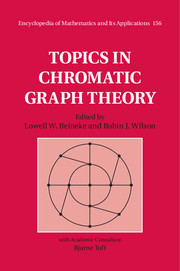Book contents
- Frontmatter
- Contents
- Foreword
- Preface
- Preliminaries
- 1 Colouring graphs on surfaces
- 2 Brooks's theorem
- 3 Chromatic polynomials
- 4 Hadwiger's conjecture
- 5 Edge-colourings
- 6 List-colourings
- 7 Perfect graphs
- 8 Geometric graphs
- 9 Integer flows and orientations
- 10 Colouring random graphs
- 11 Hypergraph colouring
- 12 Chromatic scheduling
- 13 Graph colouring algorithms
- 14 Colouring games
- 15 Unsolved graph colouring problems
- Notes on contributors
- Index
- References
2 - Brooks's theorem
Published online by Cambridge University Press: 05 May 2015
- Frontmatter
- Contents
- Foreword
- Preface
- Preliminaries
- 1 Colouring graphs on surfaces
- 2 Brooks's theorem
- 3 Chromatic polynomials
- 4 Hadwiger's conjecture
- 5 Edge-colourings
- 6 List-colourings
- 7 Perfect graphs
- 8 Geometric graphs
- 9 Integer flows and orientations
- 10 Colouring random graphs
- 11 Hypergraph colouring
- 12 Chromatic scheduling
- 13 Graph colouring algorithms
- 14 Colouring games
- 15 Unsolved graph colouring problems
- Notes on contributors
- Index
- References
Summary
R. L. Brooks's seminal paper [4] of 1941 contains the first result – known as Brooks's theorem – on colouring abstract graphs. That it is worthwhile to study the chromatic number of graphs in general, rather than just planar graphs, was pointed out already by A. B. Kempe in 1879 in his paper [28] about mapcolouring. However, it was only with the paper by Brooks that vertex-colouring of abstract graphs became a topic of study. Over the years, this topic has developed into a rich theory and, as emphasized by B. Reed in his extensive paper [51], Brooks's theorem is just the tip of the iceberg.
Introduction
In this chapter only simple graphs are considered. Brooks's theorem relates the chromatic number to the maximum degree of a graph. In modern terminology Brooks's result is as follows:
Let G be a graph with maximum degree Δ, where Δ > 2, and suppose that no connected component of G is a complete graph KΔ+1. Then it is possible to colour the vertices of G with Δ colours so that no two vertices of the same colour are adjacent, and hence G has chromatic number at most Δ.
Brooks noticed that it suffices to prove the result for connected graphs, since the connected components of a graph can be coloured independently of each other. Furthermore, he observed that every graph with maximum degree Δ admits a (Δ+ 1)-colouring, by giving to each vertex in turn a colour different from all those colours already assigned to vertices to which it is adjacent. The three missing cases, where Δ = 0, 1, 2, can be easily included in Brooks's theorem. So another possible way of formulating Brooks's fundamental result is as follows.
Theorem 1.1 (Brooks's theorem) Let G be a connected graph of maximum degree Δ. Then χ(G) ≤ Δ+1, where equality holds if and only if G is a complete graph or an odd cycle.
Information
- Type
- Chapter
- Information
- Topics in Chromatic Graph Theory , pp. 36 - 55Publisher: Cambridge University PressPrint publication year: 2015
References
Accessibility standard: Unknown
Why this information is here
This section outlines the accessibility features of this content - including support for screen readers, full keyboard navigation and high-contrast display options. This may not be relevant for you.Accessibility Information
- 2
- Cited by
